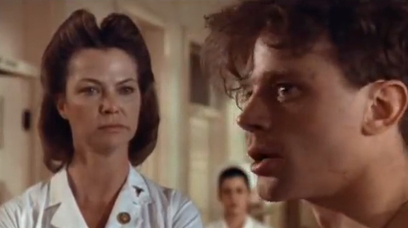 In her casual cruelty, the wretched Nurse Ratched added to our negative stereotype of asylums as places of fear and loathing.
In her casual cruelty, the wretched Nurse Ratched added to our negative stereotype of asylums as places of fear and loathing. Similarly, in the U.S., 560,000 patients were cared for in state psychiatric facilities in 1955; today—with a population that has doubled—that number has fallen 45,000. In our advanced, sophisticated societies, a large, powerless swathe of the population has been abandoned.
Is it time to reconsider the asylum? A new paper published in the Journal of the American Medical Association (JAMA) says, well, yes.
But first, a potted history: Bethlem Hospital, founded in 1247, was for centuries a dumping ground for London’s dispossessed. “Bedlam,” and the other asylums that followed, were places where those already suffering were warehoused and often cruelly punished for being “mad.” Then along came William Battie, author of “A Treatise on Madness” in 1758, who argued that asylums should be places of refuge, of healing, of rehabilitation. Some attempted to live up to that utopian vision. Many did not.
In 1961, then-health minister Enoch Powell made a controversial speech (another one!) in which he pronounced that mental hospitals had become prisons, and their inmates “institutionalised”—they’d be much better served, he said, by “care in the community.” He may have been motivated more by economics than ethics, but it coincided with the development of powerful new antipsychotic medications, and emerging ideas around patient’s rights from the civil rights movement. The 1960s saw the “antipsychiatry movement” develop, led by the likes of R. D. Laing, Thomas Szasz and Jacques Lacan—they argued that mental illness was a construct, that psychiatric treatments were often damaging and oppressive, and that people had the right to be different and not be locked up and forcibly sedated.
There were horrendous revelations in the 1980s of gross misconduct, abuse and brutality at places like Broadmoor, Rampton and Ashworth (a recent TV documentary on Broadmoor presented an altogether more uplifting story). Films like “One Flew over the Cuckoo’s Nest” played into—and added to—a culture of fear and loathing of asylums. They fell out of favour, squeezed by both sides of the political divide. A few criminal, high-security asylums like Broadmoor remain, but the rest—at one time there were 120 in England and Wales alone--were closed, the grand Victorian buildings sold off to developers. The money largely did not go towards mental health service provision. The former residents often found there was no care, no community.
In the U.S., it was a similar story. Says the JAMA paper:
Social, political, and economic forces coalesced to move severely mentally ill patients out of psychiatric hospitals. The opening of the “back doors” of state hospitals in the 1940s and 1950s marked the first phase of deinstitutionalization, as long-stay chronically ill patients were discharged. In the 1960s and 1970s, the civil rights movement propelled deinstitutionalization. Shocking reports about abuses at hospitals, such as Massachusetts’ Bridgewater State Hospital, offended the public consciousness and added momentum to closures of psychiatric hospitals. Formerly institutionalized patients who self-identified as “psychiatric survivors” had developed alternative models of peer-facilitated community treatment such as Fountain House in New York City. These models seemed like viable alternatives to institutions. New drugs, especially chlorpromazine, made outpatient options and the ability to live independently seem both liberating and promising.
The reality has been somewhat different. Continues the report:
Deinstitutionalization has really been transinstitutionalization. As state hospitals were closed, patients with chronic psychiatric diseases were moved to nursing homes or to general hospitals where they received episodic psychiatric treatment at significantly higher costs. Others became homeless, utilizing hospital emergency departments for both care and housing . . . Most disturbingly, US jails and prisons have become the nation’s largest mental health care facilities. Half of all inmates have a mental illness or substance abuse disorder; 15% of state inmates are diagnosed with a psychotic disorder.
Concludes the report:
For persons with severe and treatment-resistant psychotic disorders, who are too unstable or unsafe for community-based treatment, the choice is between the prison–homelessness–acute hospitalization–prison cycle or long-term psychiatric institutionalization. The financially sensible and morally appropriate way forward includes a return to psychiatric asylums that are safe, modern, and humane.
“It’s really not as radical as it sounds,” the report’s lead author, Dominic A. Sisti, told Quartz. Psychiatrists have been making arguments for expanding long-term inpatient care for some time, he says. Politically, economically and emotionally, there’s probably little appetite for the return of lots of asylums. And a lot of Community Mental Health Teams do an excellent job, despite ever-dwindling resources. But there is something appealing about an array of psychiatric services that includes the possibility of refuge in “safe, modern, and humane” patient-centred facilities, somewhere to go besides A&E, prison or the street, where the focus is on care rather than confinement, development rather than detention, rehab rather than restriction. Where the original meaning of the term asylum—a place of sanctuary, support and treatment—is honoured. Where the staff aren’t like Nurse Ratched.
More than a quarter of a millennium ago, Battie wrote that we have the pleasure “to find that Madness is, contrary to the opinion of some unthinking persons, as manageable as many other distempers, which are equally dreadful and obstinate, and yet are not looked upon as incurable: and that such unhappy objects ought by no means to be abandoned.”



